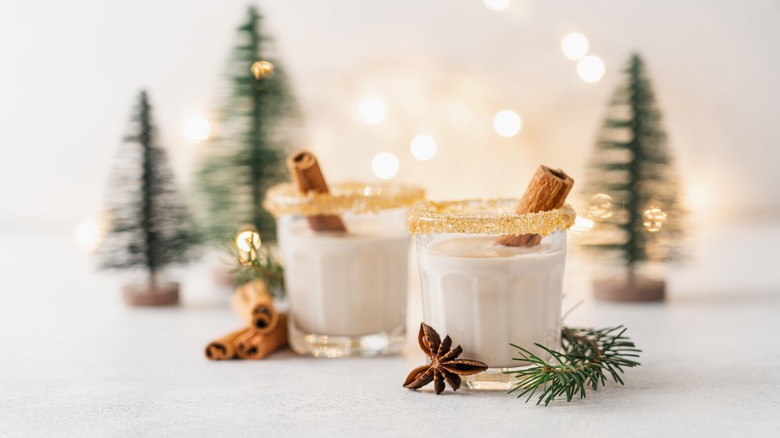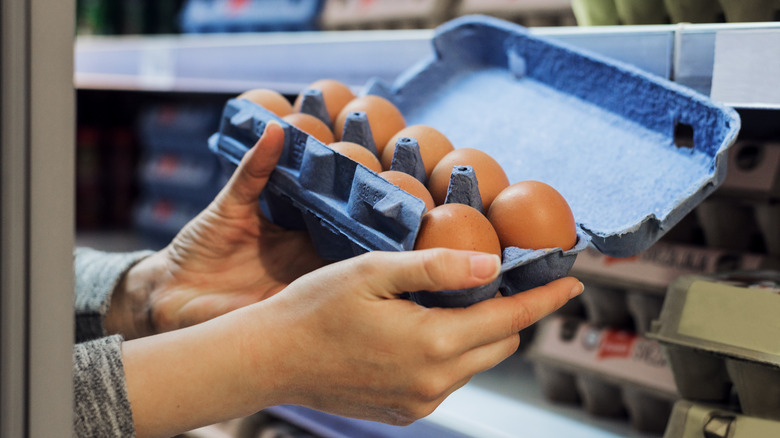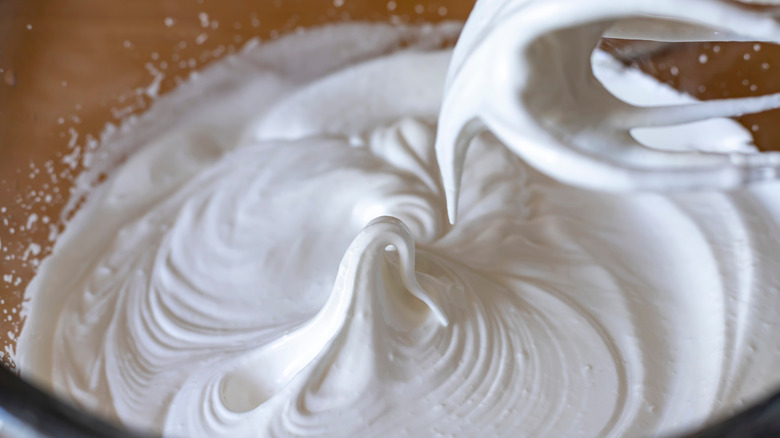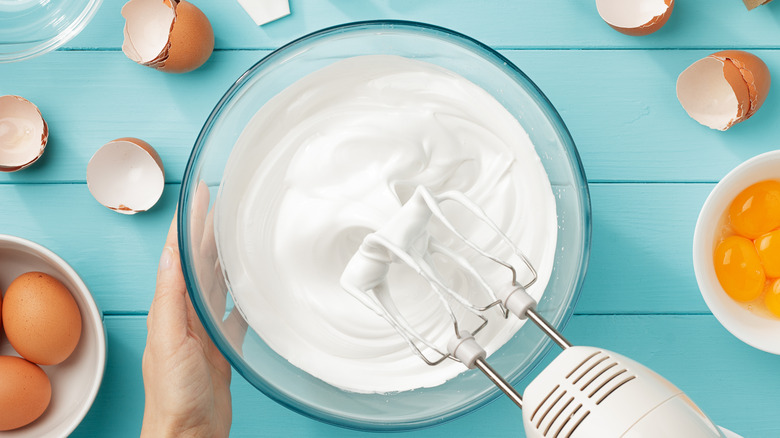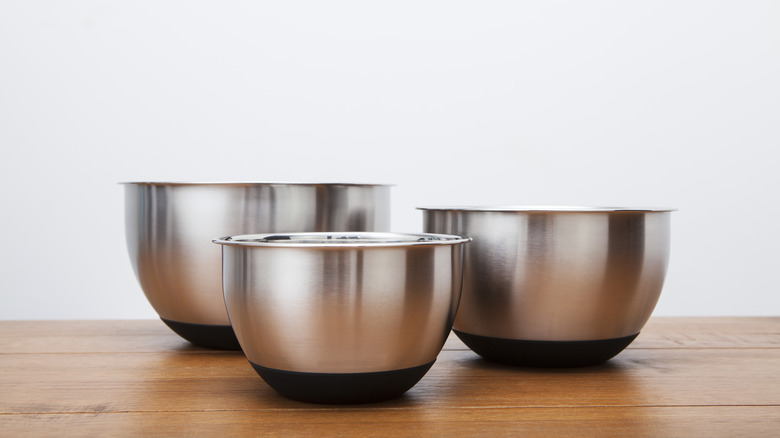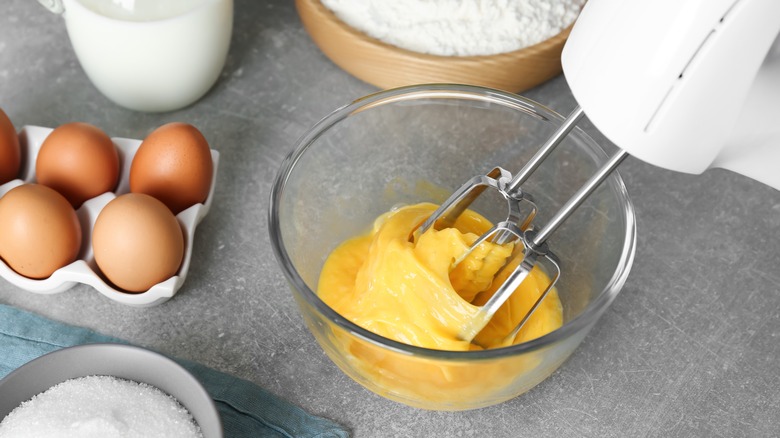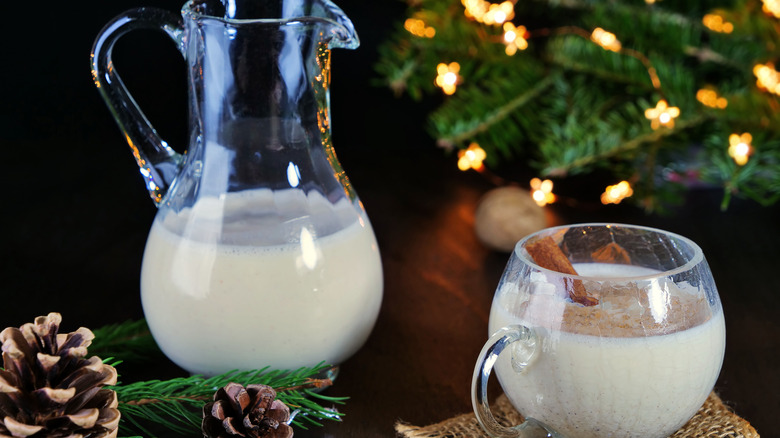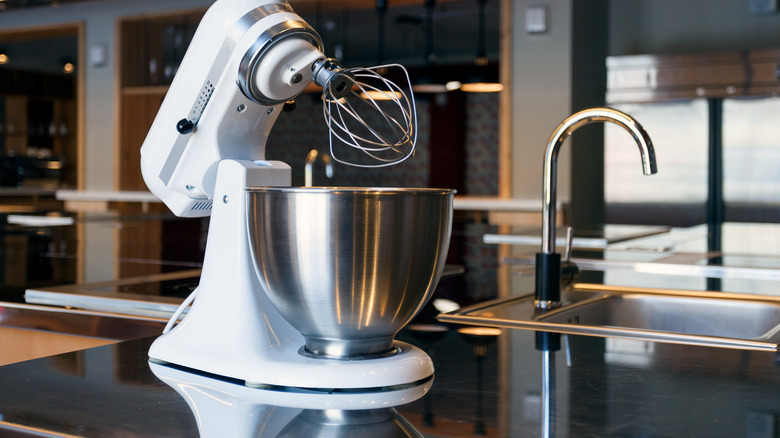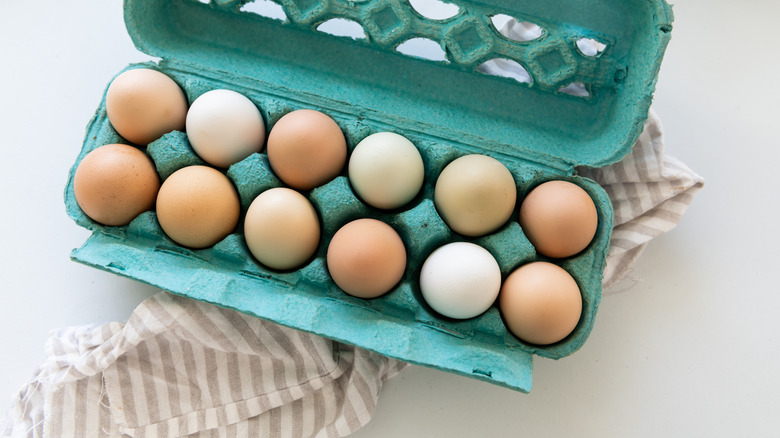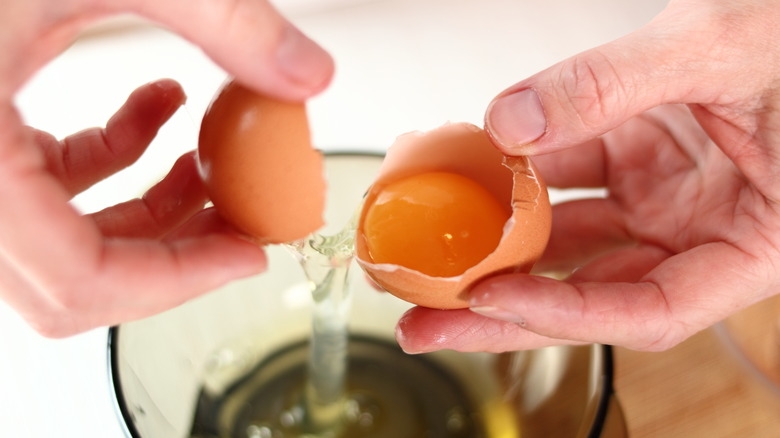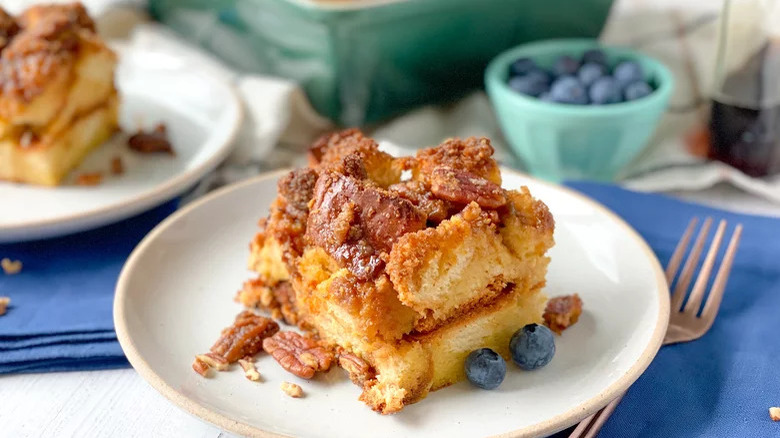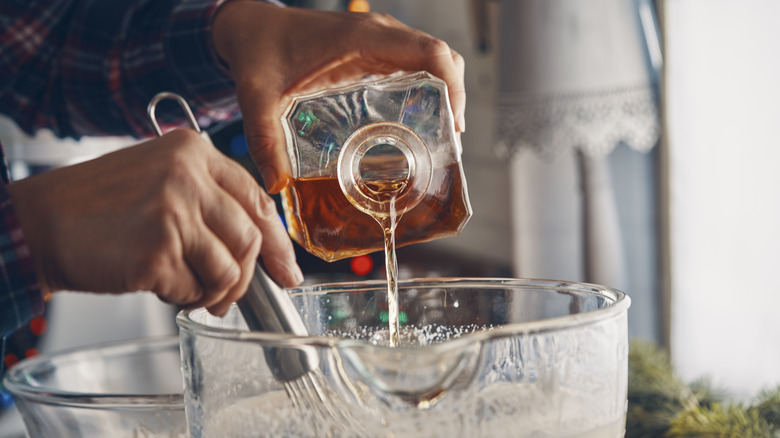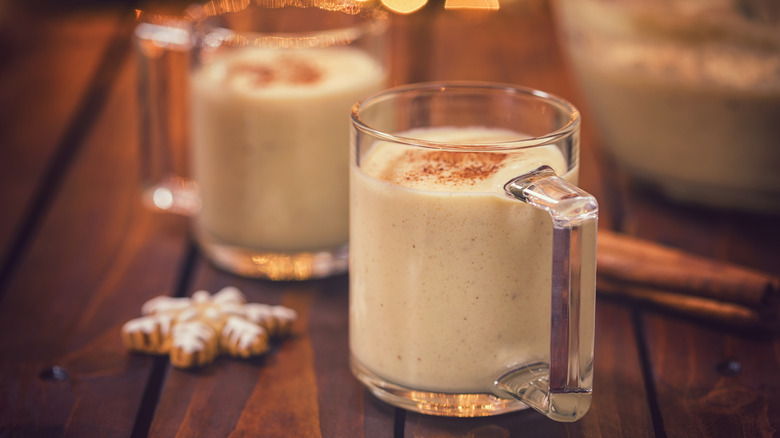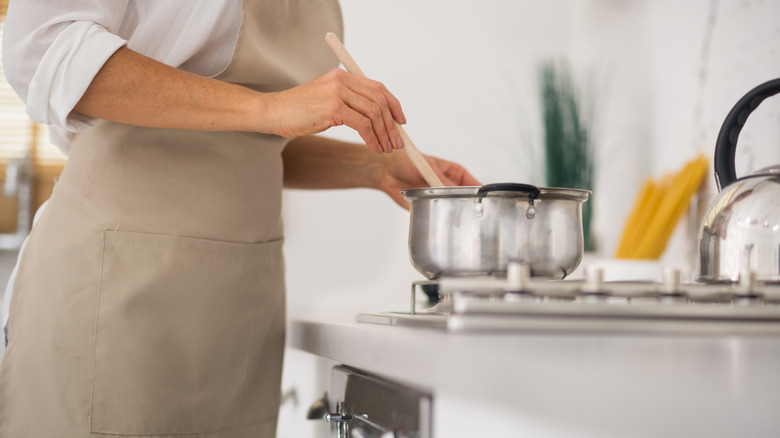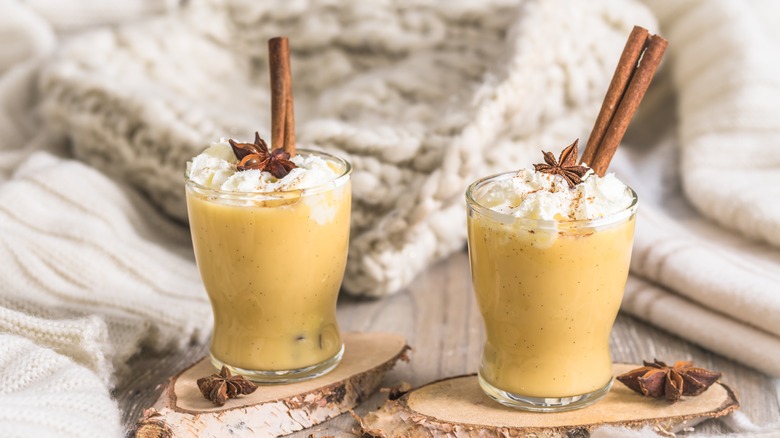16 Mistakes Everyone Makes With Homemade Eggnog
As the weather cools and the holiday season draws near, there's a noticeable shift in what we find on grocery store shelves. The once unadorned, rather boring shelves come alive with seasonal delights. Among these, the classic eggnog holds a special place in our hearts. Sure, grabbing a carton of eggnog from the store works in a pinch, but nothing compares to the divine experience of making eggnog from scratch at home.
If you're not already an eggnog enthusiast, especially if your experience is limited to store-bought varieties, we strongly encourage you to try your hand at homemade eggnog before declaring yourself an eggnog naysayer. Homemade eggnog is not just delicious; it's surprisingly simple to make. However, it's also easy to veer off course during its preparation.
So, as you embark on your journey to create this rich, fluffy, and utterly delightful drink at home, it's crucial to arm yourself against the common mistakes that can arise. Knowing what pitfalls to avoid when perfecting your homemade eggnog can make all the difference, transforming your holiday beverage experience from just okay to absolutely spectacular.
Not using fresh eggs
If you're gearing up to make fresh eggnog for your next holiday gathering, remember that the use of fresh eggs is not just a suggestion but a necessity for safety. It's always better to grab fresh eggs from the grocery store rather than trust your memory about the age and reliability of the eggs you have at home.
Even when you buy fresh eggs, it's wise to give them a quick smell test after you crack them. If they emit a deeply unpleasing odor, it's a strong indicator that they are not safe to use, even if they're fresh from the store. Your nose can be a reliable tool in determining egg safety.
Using eggs that are anything less than fresh can pose a risk, especially in recipes like eggnog, where the eggs aren't cooked. To avoid any health hazards, always opt for the freshest eggs available and trust your senses to guide you in assessing their quality.
Underestimating how long you should whip
When making eggnog, especially the unheated kind, a common step in the recipe is to whip the egg whites into soft peaks. This task, while not as time-consuming as achieving stiff peaks, still requires some attention and effort. To identify when you've reached the soft peak stage, watch for when you lift your mixer out, and the tip of the whipped egg whites gently folds over. This is your cue that you've hit the soft peak stage.
In contrast, stiff peaks are a bit further along in the whipping process. You'll know you've reached stiff peaks when, upon lifting your mixer, the egg-white peak stands up straight without folding over. This stage occurs just beyond the soft peak phase.
To ensure you achieve the desired consistency, whether it's soft peaks for your eggnog or stiff peaks for other recipes, it's crucial to check the egg whites frequently as you whip them. This way, you can stop at the exact point you need for your recipe, avoiding over or under-whipping. Monitoring the process closely will help you get the perfect texture for your eggnog, ensuring it's both safe and delicious for your holiday festivities.
Whipping by hand
Whipping egg whites into soft peaks for eggnog can indeed be a time-consuming task, and a common error that many people make is assuming they can do it effectively by hand. We strongly advise against this approach. Hand whipping is exhausting, and you're likely to grow tired long before achieving the desired soft peaks. Even those with significant upper arm strength find it challenging to maintain the consistent, vigorous motion required to whip egg whites properly by hand.
For a more efficient and less tiring method, opt for using either a handheld electric mixer or a stand mixer. A stand mixer, if available, is particularly recommended as it is the most convenient and effective tool for this job. It allows for a consistent, even speed and requires minimal effort from you. It's simple to check for soft peaks here; simply lift the whisk out and observe the behavior of the whipped egg whites.
Using bowls that are too small
When you start whipping the ingredients for your eggnog, it's easy to underestimate the size of the preparation bowls needed. It's a wise move to use bowls that are much larger than you think you'll need. This approach significantly reduces the risk of overflow, which can happen as the volume of the ingredients increases during the whipping process.
Using larger bowls from the beginning helps to keep everything contained and manageable. If you opt for a bowl that's too small and find yourself needing to switch to a larger one mid-process, not only is it inconvenient and cumbersome to manage, but it also means you'll end up with more kitchenware to clean afterward. By choosing a generously sized bowl right from the start, you streamline your preparation process and keep cleanup to a minimum, making your eggnog-making experience smoother and more enjoyable simply by planning ahead.
Beating eggs and sugar together
When preparing eggnog, alongside whipping your egg whites, you'll also need to whip the yolks. A crucial tip from culinary expert Alton Brown is to avoid adding sugar directly into the egg yolks at the start. This common misstep can significantly impact the texture and quality of your eggnog.
If you mix sugar into the yolks without whipping them first, you risk creating a chunky and unappealing texture in your eggnog. The key is to first thoroughly whip the egg yolks until they are smooth and well-aerated. Only after you've achieved that dreamy, consistent, creamy texture with the yolks can you gradually add sugar.
This method ensures that the sugar integrates smoothly into the yolks, enhancing the overall texture and flavor of your eggnog. By following this approach, you avoid the textural issues that can arise from improper mixing and achieve a smooth, creamy, and delicious eggnog that's perfect for your holiday festivities. This is also one of the ways to separate the homemade stuff from the premade nog at your local grocery store.
Underestimating how much a batch makes
When making eggnog, it's quite common to miscalculate not just the size of the preparation bowl needed but also the quantity of the final product. This can lead to producing a much larger batch of eggnog than anticipated.
If you're hosting a large holiday gathering, having an abundance of eggnog might not pose any issues, as it's likely to be enjoyed by many guests. However, if your event is smaller, you could find yourself with an excessive amount of eggnog, more than what you and your guests can reasonably consume.
To avoid this, it's a good idea to carefully consider the number of guests and their likely consumption when planning your eggnog recipe. Adjusting the recipe proportions to suit the size of your gathering can help ensure you make just the right amount of eggnog. This prevents waste and helps manage the preparation and storage logistics.
Forgetting about storage
So what do you do with an enormous amount of nog? Store it! If you've underestimated the quantity your recipe yields, you might not have thought about how to store the excess. A smart move is to keep several large, sealable pitchers, preferably reserved mainly for eggnog. This ensures you have the right container size and type to keep your nog fresh.
As for where you should be storing your eggnog in the refrigerator, it's quite important. After decanting your eggnog into these hefty containers, position them towards the back of your fridge. The rear of the fridge usually experiences less fluctuation in temperature compared to the front, which is frequently exposed to warmer air every time the fridge door opens. Plus, this spot is more shielded from light exposure. By adopting these storage strategies, you can enjoy your homemade eggnog throughout your holiday celebrations without worrying about waste or spoilage.
Starting with room temperature equipment
After years of experience in making eggnog, a useful tip we've discovered is to refrigerate the metal mixer bowl and mixing attachments before using them. This simple step can make the whipping process smoother and more efficient. Additionally, it helps in keeping the ingredients cold, which is crucial for achieving the desired chill in the final eggnog.
Before placing these items in the refrigerator, it's important to thoroughly wash them. This ensures that they're clean and ready for use. Plus, by cleaning them beforehand, you avoid the possibility of having to warm up the bowl by washing it after it's been chilled in the refrigerator. This pre-chilling technique not only improves the quality of the eggnog but also aligns with the expectation of serving a deliciously cold beverage during your holiday festivities, as well as taking that sip right after you finish preparing the batch.
Missing the fact that it's largely raw eggs
When thinking about preparing eggnog, it's sometimes easy to overlook the fact that this festive drink is predominantly made from eggs. Indeed, while milk, cream, sugar, and occasionally alcohol are key ingredients, the fundamental components of eggnog are the egg yolks and whites.
For those who might find the high egg content concerning, particularly due to the risks associated with raw eggs, there are ways to mitigate these concerns. One effective method is to incorporate a warming step into the preparation process. Heating the eggnog can help reduce the risk of foodborne illnesses associated with raw eggs.
Additionally, we highly recommend using pasteurized eggs in your eggnog recipe. These pasteurized eggs will have been heat-treated in order to kill bacteria without actually cooking the egg. This process will make them safer for recipes where eggs are not fully cooked, like eggnog.
Keeping yolks and whites in tact
In most eggnog recipes, a key step involves separating a dozen eggs into yolks and whites. This step, though simple, can be surprisingly easy to overlook. However, achieving the right consistency and texture for light, fluffy, and smooth eggnog depends heavily on this separation.
To ensure you don't skip this crucial step, it might be helpful to make egg separation the very first task as soon as you take your eggs out of the refrigerator. You'll be whipping them in separate bowls anyway, so get ahead by simply putting them in separate bowls right away. By doing this in the beginning, you ensure that the eggs are ready before you even begin gathering the rest of your ingredients. This early separation sets the stage for the rest of the preparation process, helping you to focus on achieving the perfect balance and texture for your delicious, seasonal eggnog.
Forgetting your vegan friends
Classic eggnog, with its reliance on eggs and dairy, is certainly not vegan-friendly. However, that doesn't mean your vegan friends have to miss out on the joy of this festive drink. A vegan eggnog recipe can be just as delicious, using alternative ingredients that might seem unconventional for eggnog, such as dates, almond milk, and cashews.
Dates in a vegan eggnog recipe add natural sweetness, while cashews when blended, create a perfectly creamy texture mimicking the richness typically provided by eggs and dairy. We find soaking them ahead of time works wonders for blending. The addition of classic eggnog seasonings like nutmeg, cinnamon, and cloves brings in the traditional flavors that everyone loves about eggnog.
One of the great aspects of this vegan eggnog is that it becomes wonderfully smooth when blended. This texture is key to a good eggnog, and the combination of these ingredients ensures that the vegan version doesn't fall short in this regard. We also love this recipe as a delicious seasonal vegan creamer for your coffee.
Missing opportunities to use leftovers
Utilizing leftover eggnog in creative and festive ways can be both fun and practical, especially when you have a large batch. One excellent idea is to make an Eggnog French Toast Casserole, perfect for a delightful Christmas morning breakfast. This recipe transforms this festive drink into a warm, comforting dish that's sure to become a holiday favorite.
To prepare it, start by cubing your choice of bread and placing it in a large casserole dish. In a separate bowl, mix together eggs, eggnog, and your chosen seasonings to capture those quintessential holiday flavors. Pour this mixture over the bread cubes, ensuring they're well-coated, and then refrigerate for a few hours.
The final touch is a delicious crumble topping. Once topped with this crumble and baked, your Eggnog French Toast Casserole is ready to delight and potentially start a new Christmas morning tradition. It's a wonderful way to repurpose leftover eggnog and add a festive flair to your holiday breakfast.
Serving without spirits
If your holiday gathering is exclusively for adults or if the children won't be partaking in the eggnog, spiking your eggnog with alcohol can add an extra festive touch. Martha Stewart recommends a trio of spirits for enriching eggnog: dark rum, bourbon, and cognac. This combination brings a depth of flavor and warmth to the drink, making it a perfect choice for holiday celebrations.
The proportions of these spirits can be adjusted according to your preference. Stewart suggests using the most bourbon, followed by a smaller amount of cognac, and then just a touch of dark rum. This blend balances the flavors between a strong base, a little smoothness, and, finally, some sweetness.
Of course, the beauty of making your own holiday eggnog is the flexibility to tailor it to your taste. Feel free to omit or substitute them with your preferred liquor if you're not fond of one or more of these spirits. The key is to achieve a balance that complements the creamy richness of the eggnog, creating a delightful and warming holiday drink that you and your adult guests will flock to.
Using liquor with too high proof
On the other hand, if you prefer to serve eggnog and alcohol separately, which allows guests to customize their own drinks, adhering to a specific ratio is a good idea for maintaining the balance of flavors. When spiking your holiday eggnog, we recommend one part alcohol to five parts eggnog. This proportion ensures that the alcohol bite enhances the eggnog without overpowering it.
Eggnog can easily become overwhelmed if too much alcohol is added. The creamy and rich flavors of the eggnog should remain the star, with the alcohol providing a complementary note. By keeping the eggnog and booze separate, you also cater to guests' individual preferences; some might enjoy a stronger drink, while others might prefer their eggnog with just a hint of alcohol or none at all. We love the idea of making a bar of sorts around your nog with accompaniments guests may add to their own cups. So that the kids don't feel left out, consider adding sprinkles or whipped cream as possible toppings alongside the more adult offerings.
Boiling your eggnong
Though not all recipes call for it, if you choose to warm your eggnog to pasteurize it, it's absolutely essential that you pay close attention to the temperature. Aim to heat the eggnog to around 160 degrees F. This temperature is sufficient to pasteurize the eggs, making them safe to consume without cooking them.
It's crucial to ensure that the temperature does not reach 212 degrees F, the boiling point of water. Allowing the eggnog to boil can lead to a major textural mishap. At boiling temperatures, the eggs in the eggnog can start to cook and solidify, resulting in a chunky and unappealing eggnog. These chunks from the eggs do their thing by coagulating and beginning to form curds. Of course, this is the last thing you want in your smooth, creamy eggnog. To prevent this, have a cooking thermometer on hand to check the temperature frequently.
You're making the same one-note mix
Sticking to the same simple eggnog recipe every year can be a missed opportunity to explore the delightful variations this festive drink can offer. For instance, adding a secret ingredient like vanilla bean can transform the traditional eggnog flavor into something even more special, enhancing its richness and depth.
There are numerous global variations of eggnog that bring unique flavors and ingredients to the table. In Puerto Rico, for example, there's a popular version known as coquito, which includes cream of coconut, giving it a tropical twist that's distinct from the classic eggnog.
Another interesting variant is Ponche Crema from Venezuela. This eggnog-like beverage incorporates a citrus twist, adding lemon zest and even lime to the traditional mix of milk, cream, eggs, spices, and sugar for a refreshing, tangy flavor with that extra citrus brightness not typically part of your everyday, traditional eggnog recipe.
